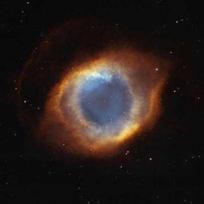"The Eye of God"
Matt Lowry
One day in the middle of last November, I was doing my usual thing, checking the email after a long day of teaching, and hoping there wasn't too much spam to deal with. Of course there's always spam (darn it), and on this day I'd received a chain email from my mother-in-law entitled "The Eye of God".
Knowing that my mother-in-law tends to be a pretty religious and smart woman, I was curious enough to open the email rather than just relegating it to the trash bin like many other chain emails I get. It ends up that I'd heard of this particular email floating around, and I thought this the perfect opportunity to do some astronomical education.
The gist of her email (which she simply passed along... it's a chain email after all) was this:
"Eye of God - you really must see this!"
 And accompanying the email was a stunning image, which I share with you here. Indeed, at first glance, it appears as if there is a great cosmic eye staring back at you when you view the image. And, I must admit, when first confronted with this image, it was difficult to overrule the part of my mind that wanted to instantly conclude that I was gazing into the "eye" of some great cosmic being.
And accompanying the email was a stunning image, which I share with you here. Indeed, at first glance, it appears as if there is a great cosmic eye staring back at you when you view the image. And, I must admit, when first confronted with this image, it was difficult to overrule the part of my mind that wanted to instantly conclude that I was gazing into the "eye" of some great cosmic being.
In fact, many of you may recognize that this is a real photograph of the Helix Nebula, although it's technically not a single photograph but rather a composite image formed from several photographs taken by NASA's orbiting Hubble Space Telescope and a land-based telescope at the Kitt Peak National Observatory near Tucson, Arizona.
The "eye-like" appearance of the nebula comes from the fact that as a planetary nebula, the outer gasses of the star were expelled into space, leaving behind a stellar core as the "pupil". So it appears from our vantage point as if we are looking down a helix, because we are actually looking through a thin portion of the shell of gas blown off the star -- a common feature of planetary nebula, such as with the Ring Nebula. The remnant central stellar core, destined to become a white dwarf star, glows in light so energetic it causes the previously expelled gas to fluoresce with a bluish-green color, mimicking the colored iris of a human eye.
There are numerous other nebulae that seem to take on the appearance of the human eye, and even one called the Cat's Eye Nebula because it has the appearance of, well, of a cat's eye. Pretty spooky stuff... apparently, there are not only great cosmic humans occupying the sky looking down upon us, but their pets as well. I hope kitty doesn't get too hungry.
Actually, this sort of phenomenon, that of seeing familiar shapes and structures where they don't really exist, is rather common. It's called "pareidolia", and we've all ex-perienced it at some time or another -- seeing a doglike shape in the clouds, or noticing that a peculiarly shaped rock looks like the profile of a face, or (as some fervent believers maintain) seeing images of Christ or the Virgin Mary in a grilled-cheese sandwich. Perhaps the most famous space-related occurrence of pareidolia is the infamous Face on Mars, which is in reality nothing more than a pile of rocks.
The reason behind pareidolia is pretty clear: as humans, we have evolved to recognize familiar faces and shapes, and when we are presented with a pattern that seems to match something familiar, our mind fills in the gaps, giving us the impression that we really are looking at a dog, human face, or a deity. This same principle is how many simple, and quite entertaining, optical illusions work.
So, in true skeptic and educator form, I responded to my mother-in-law, basically outlining for her what I'd outlined for you just now. In addition, I noted that even though I disregarded any religious significance to the Helix Nebula image, it was definitely a great photo of a truly amazing object in the sky. And I went on to say that it was only one of many such objects, and that understanding the true nature of the night sky, as opposed to allowing the more primitive sections of our brain to "fill-in the gaps" and cloud our reasoning, was the real gift.
Ad Astra -- Matt Lowry
Published in the March 2005 issue of the NightTimes




